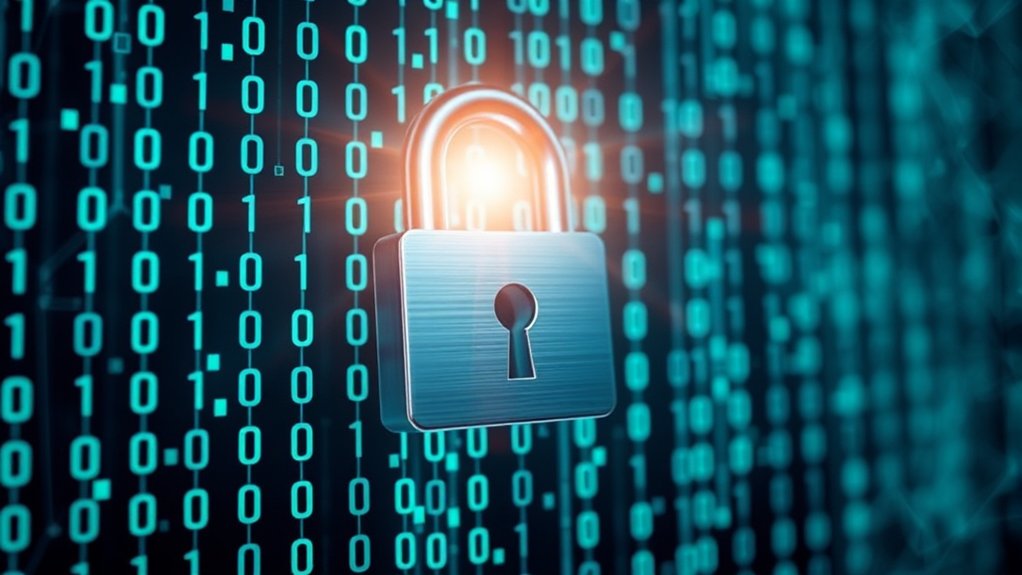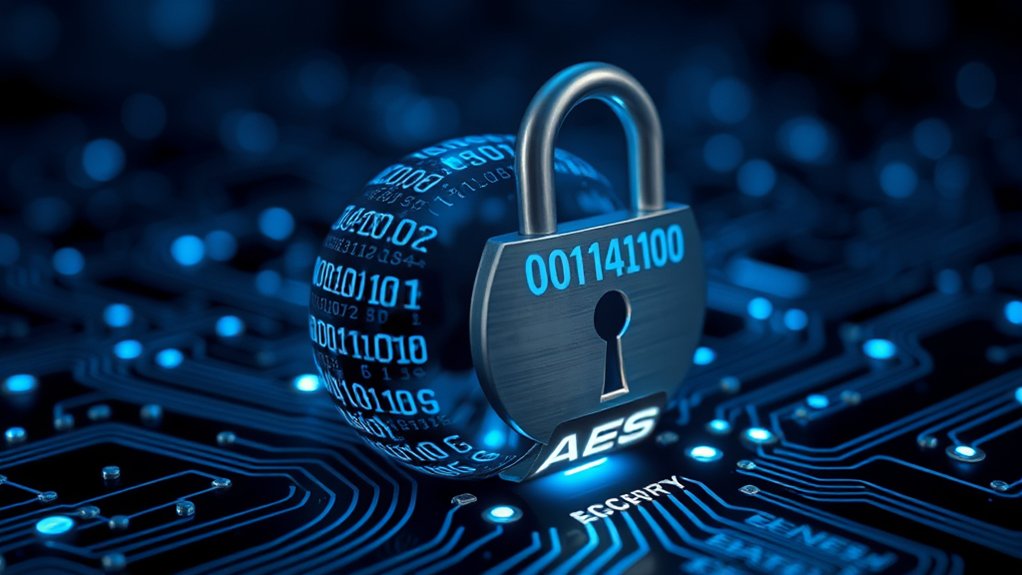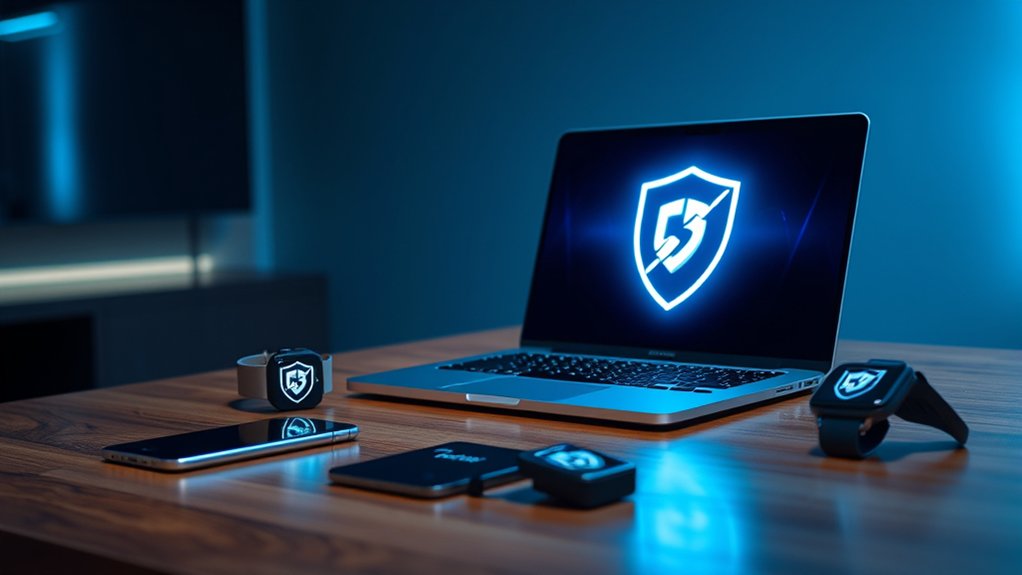AES encryption, or Advanced Encryption Standard, is a sturdy symmetric block cipher essential for securing sensitive digital information. It employs a 128-bit block size and multiple rounds of complex transformations, ensuring strong resistance against cryptographic attacks. With variants offering 128, 192, and 256-bit keys, AES is virtually immune to brute-force attempts, making it the preferred choice across industries like finance, government, and communications. Its adoption marks a significant advancement in cybersecurity, reflecting its importance in combating modern threats. Further insights reveal its wide-ranging applications and integration with existing security protocols.

As cybersecurity threats continue to evolve, AES (Advanced Encryption Standard) encryption has emerged as a cornerstone of data protection, particularly in environments involving sensitive information. This symmetric block cipher employs the same key for both encryption and decryption, making it effective in securing data. AES operates on fixed-size blocks of 128 bits, going through multiple rounds of substitution and permutation processes, which notably improve its strength. The U.S. government adopted AES as a standard for securing sensitive data, further attesting to its reliability and efficacy. Furthermore, similar to Bitdefender’s use of AI, AES remains effective against emerging threats in the cybersecurity landscape.
The security features of AES are commendable. It provides strong protection against a variety of cryptographic attacks, including brute-force, differential, and linear cryptanalysis. AES is virtually immune to brute-force attacks, especially when using 256-bit keys, as current computing technology cannot feasibly break such encryption. Additionally, AES is designed to be resistant to practical cryptanalytic attacks, ensuring that it remains a robust choice for data security. Its robust security has made it a preferred standard across multiple industries, further demonstrating its importance in protecting sensitive information.
AES security features are impressive, offering robust defense against cryptographic attacks, particularly with 256-bit key strength against brute-force attempts.
In addition, AES integrates smoothly with other security protocols like SSL and WPA2, providing layers of security that are essential in today’s digital environment.
Equally important is AES’s efficiency and performance. It requires less computing power and memory compared to older encryption methods, such as DES, making it suitable for diverse environments. AES’s compatibility with various operating systems and programming languages facilitates its integration, whether in hardware or software contexts.
It can handle substantial data volumes effectively, minimizing latency in applications, which is particularly advantageous for cloud storage and streaming services.
AES finds extensive applications across the cybersecurity spectrum. It secures online communications in VPNs and strengthens Wi-Fi security protocols. This encryption method is likewise employed in password managers, financial platforms, and various file systems.
Moreover, AES plays a critical role in military and government communications, safeguarding classified information with high-level security protocols. Its trusted reputation and efficiency make AES indispensable in the ongoing fight against cyber threats, providing peace of mind in a environment fraught with potential vulnerabilities.
Frequently Asked Questions
How Does AES Compare to Other Encryption Methods?
AES encryption compares favorably against other methodologies, particularly Blowfish and Triple DES.
With key sizes of 128, 192, or 256 bits, AES greatly outperforms Triple DES, which utilizes three 56-bit keys equivalent to roughly 112 bits.
Furthermore, AES’s block size of 128 bits surpasses Blowfish’s 64 bits, enhancing data security.
Its efficient operations make AES preferable for bulk encryption, consolidating its status as a leading choice in modern cybersecurity practices.
Is AES Encryption Suitable for Personal Use?
AES encryption is highly suitable for personal use because of its strong security, ease of implementation, and versatility across various platforms.
It supports key sizes of 128, 192, and 256 bits, enabling tailored security levels. Furthermore, AES’s resistance to common attacks and widespread adoption improve user confidence.
Its compatibility with most devices, including smartphones and desktops, allows individuals to encrypt files and secure communications efficiently, meeting diverse data protection needs effectively.
What Are Common Vulnerabilities in AES Encryption?
Common vulnerabilities in AES encryption primarily arise from implementation flaws rather than weaknesses in the encryption algorithm itself.
Related-key attacks exploit key scheduling deficiencies, with complexities as low as \(2^{96}\). Known-key attacks target reduced-round configurations, though they do not threaten standard implementations.
Side-channel attacks, including cache-timing methods, utilize environmental data. Proper configurations and adherence to security protocols are essential in mitigating these vulnerabilities, as improper key management greatly compromises AES effectiveness.
How Long Does It Take to Encrypt Data Using AES?
The time required to encrypt data using AES encryption varies depending on several factors. Typically, AES is recognized for its speed; typical software implementations can encrypt data in microseconds.
For instance, AES-128 completes 10 rounds of processing for each block, whereas AES-256 runs 14 rounds.
Furthermore, the performance benefits from hardware acceleration in modern CPUs, which greatly reduce processing time, making AES suitable for real-time applications such as secure communications and file storage.
Can AES Be Broken With Quantum Computing?
Current discussions among experts suggest that whereas AES encryption is strong against conventional computing attacks, its future against quantum computing remains uncertain.
Current 256-bit AES keys are deemed secure, yet quantum algorithms may eventually threaten this security.
As noted by cryptography specialists, the potential emergence of quantum computers could render existing encryption methods vulnerable.
As a result, research into quantum-resistant cryptographic standards is underway, aiming to safeguard sensitive data against possible future vulnerabilities in AES.









